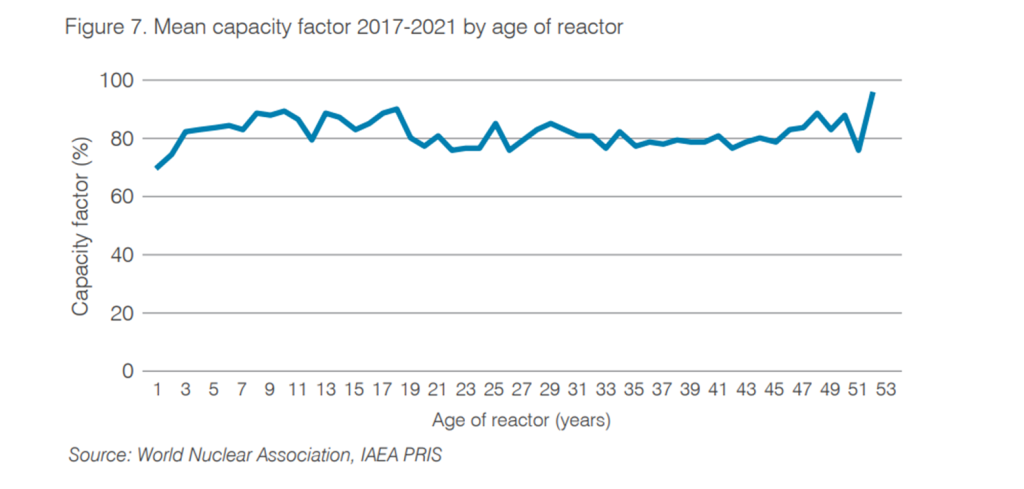One gigawatt (GW) of electricity from a nuclear power plant differs from 1 GW of coal power, natural gas, or renewable energy (Solar, Wind, Water). You cannot compare these 1:1.
Nuclear capacity factor #
Then we looking at the reliability of energy generation sources, capacity factors are a important metric. . It estimates what percentage of the time an energy source would produce energy during the year if it ran non-stop. A capacity factor of 100% means that an energy source has always produced electricity throughout the year.
The nuclear capacity factor is among the highest among the various energy sources. The last 50 years have seen a steady improvement in reactor performance. The average global capacity factor has increased since the 1970s. was in the year 2021 at 82.4% [1]. Regionally, it can be made even higher. For 20 years, the USA has maintained an average capacity factor close to 90%. For 2021 at 92.7% [2]. The highest of all energy sources in the United States [3].

Figure 1. The global capacity factor for nuclear power in the year 2021 stood at 82.4%. It continued the trend since 2000.
The average global capacity factor has been improved in reactors of all ages, not just new reactors of more advanced design. There is no age-related decline in the performance of nuclear reactors.

Figure 2: The average global capacity factor after age
The reason for the high nuclear capacity factor, is that it requires less maintenance and are designed to operate for extended periods before fuel switching and are rarely paused because they do not rely on external factors to work efficiently.
Other thermal energy sources, such as natural gas and coal power, have generally lower capacity factors [4]. It it’s due to routine maintenance and filling at these plants. Renewable energy sources are variable. It is not always the sun shining, the wind blowing, or the water falling through the turbines of the hydropower plants. Therefore, these also have lower capacity factors.

Figure 3: World capacity factor. The solid line is for the capacity factor, and the dashed line shows weighted capacity factor for the respective year. By Bolson et al. 2022 [4].
Predictable Supply #
The lack or reliability of supply was always the biggest issue with oil and gas. Their biggest asset was that you could burn them whenever you want. Solar and wind power are limited by daylight hours and the wind blowing.. Nuclear has the best of both worlds.
We’ve been reliably producing nuclear energy 24/7/365 for over 50 years. France has generated over 70 of its electricity from nuclear for decades—the US, 20%.

Supply Matches Demand #
Load-following nuclear power plants can ramp supply up or down fast—up to 5% per minute, so within 20 minutes they can go from shut down to full capacity. Nuclear reactors in France already operate this way.
Sources #
2. https://www.eia.gov/electricity/monthly/epm_table_grapher.php?t=epmt_6_07_b
3. https://www.energy.gov/ne/articles/nuclear-power-most-reliable-energy-source-and-its-not-even-close
4. Capacity factors for electrical power generation from renewable and nonrenewable sources | PNAS




